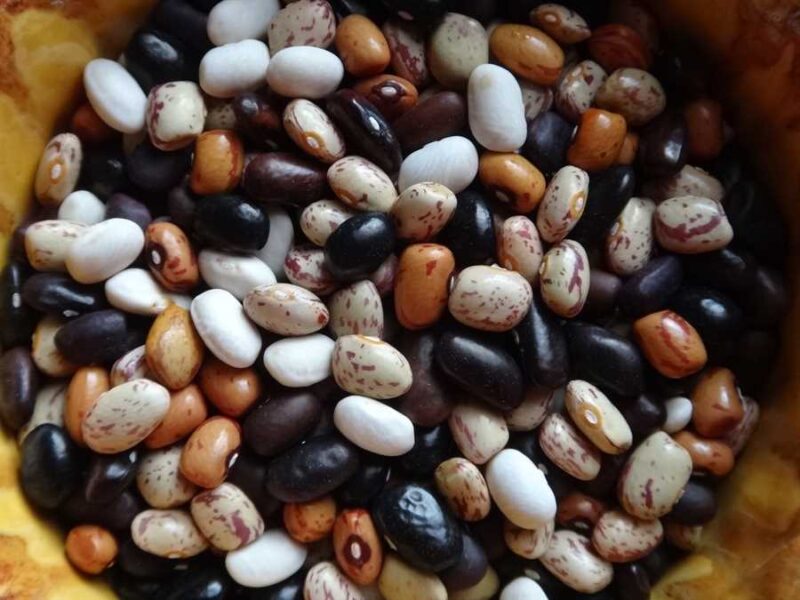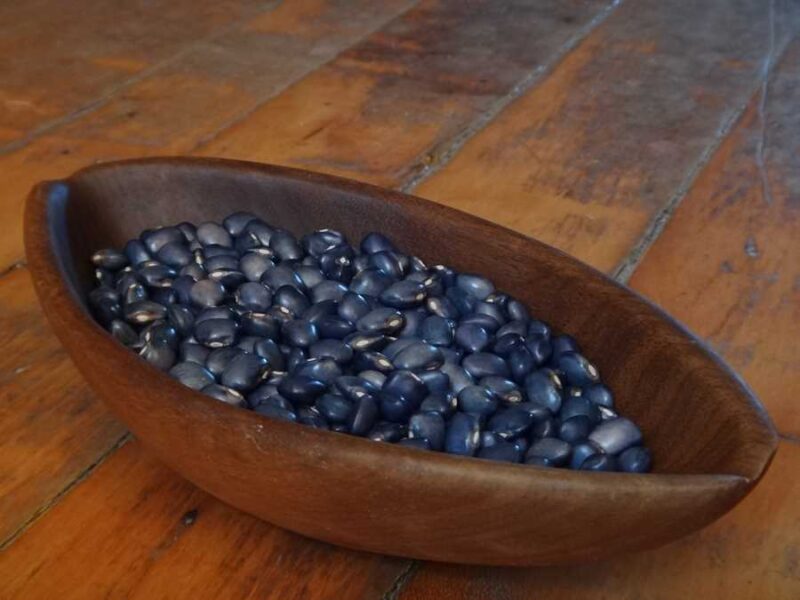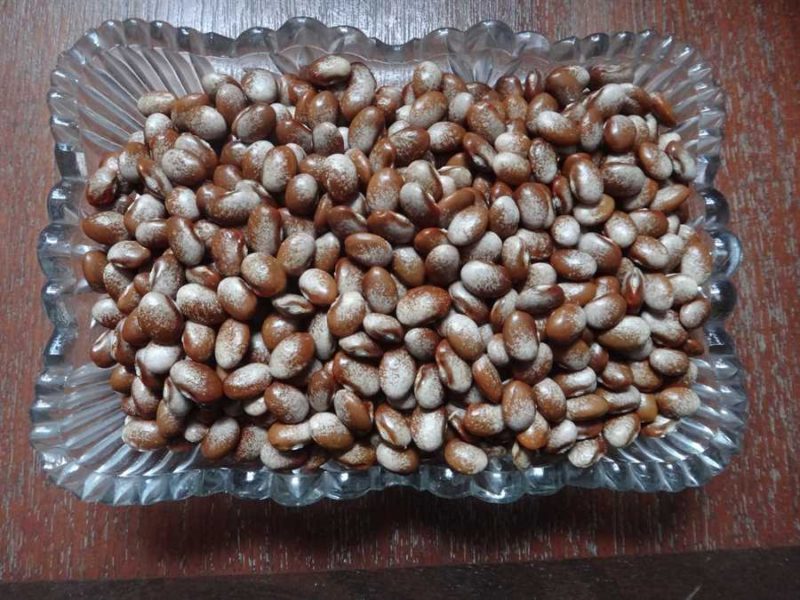Skip to content

-
-
-
$4.00
- (Pisum sativum) A 5'/1.6 m tall ''grey'' pea. Large, olive-green wrinkled seeds with distinctive dark hila. Matures about 3 weeks later than most dry peas, and therein lies a sort of long story, so please make sure you are settled comfortably before reading on. For my personal diet, I divide dry peas into two classes: grey (large wrinkled seeds that retain their shape when cooked and are used more like…
- Add to cart
-
-
-
$4.00
- (Pisum sativum) 3-5’/1-1.6 m tall. This delightful little pea is a landrace from Umbria in the Apennine mountains of central Italy, where it is called “roveja” or “roveglia”. It has grown in that area for centuries certainly, millenia probably; some say that humans started foraging it there during the Neolithic, and later domesticated it. If so, it may show us what the ancestors of all our other peas looked like.…
- Add to cart
-
-
-
$4.00
- (Phaseolus vulgaris) Pole bean from northern China with enormous, flat pale green Romano-type pods which get 10-12” long and stay tender. Impressively productive. Also called Lao Lai Shao.
- Add to cart
-
-
Out of Stock
-
$4.00
- (Phaseolus vulgaris) Pole, 8”/ 2.6 m tall. Flattish orange seeds with darker orange speckles resemble Lima beans. This bean entered Seed Savers Exchange Seed Network through Leigh Hurley in 1986; she had received it from Hattie Gray of West Burke, Vermont, who had grown it for years and used it for baked beans which she served at church suppers. Hattie told Leigh that it came from Roy Dolloff in Burke…
- Read more
-
-
Out of Stock
-
$4.00
- (Phaseolus vulgaris) Pole, 5-8’/1.6-2.6 m tall; grows well on corn. Pods filled with classic pinto beans, which have a smooth, buttery flavour; also just fine as a green bean, though it has strings. I acquired this bean from Heritage Harvest Seeds in Manitoba; they say it came from the Seneca. My favourite pinto. 85 days to maturity. 30 seeds/packet.
- Read more
-
-
Out of Stock
-
$4.00
- (Phaseolus vulgaris) Pole, 8-10’/2.6-3 m tall. Vigorous, productive vines produce orb-shaped tan beans with darker brown striping. One of our highest yielding beans, but be warned: they take their time getting established before bearing, and use every day of the growing season here. Thanks to an early frost I discovered that they will finish drying down just fine even after frost kills their leaves. The name of this bean refers…
- Read more
-
-
-
$4.00
- (Lathyrus sativus) A plant with many common names also called khesari, cicerchia, Ethiopian lentil, and chickling vetch. If you find lentils too hard to grow in our climate this plant is a good substitute, but it is really its own unique crop. Tan/green wrinkled seeds look like a cross between a lentil and a pea and taste deliciously like that cross. The plants are great: short, bushy vines grow into…
- Add to cart
-
-
-
$4.00
- (Phaseolus vulgaris) This “variety” is actually a mixture of a number of beans with dramatically different seed coats which have been grown together for a long time. I got it from Great Lakes Staple Seeds, but it has an interesting history before them. Apparently it was given to a Mrs. Effie Neeley (1908-2000) by her mother, Suzanne (née Wireman) Howard, after Effie married in the 1920s. Shortly afterword, she and…
- Add to cart
-
-
-
$4.00
- (Phaseolus vulgaris) Pole, 8’/2.6 m tall. If you are interested in growing Navy beans, but lack the space for them, this bean might be an ideal replacement; vigorous vines are more productive per square foot than bush beans, and it matures quite evenly, making it easy to harvest. 95 days to maturity. 35 seeds/packet.
- Add to cart
-
-
Out of Stock
-
$4.00
- (Phaseolus vulgaris) Pole 8’/2.6 m tall. Blue beans! They actually come in an interesting range of shades, from a pale gray/slate blue to a deep royal blue. Apparently the colour depends on the temperature while the seeds are growing; hotter weather makes them grayer, while cooler weather makes them bluer. All of them darken as they age, like most beans. We found that we got good blue colour by growing…
- Read more
-
-
-
$4.00
- (Phaseolus vulgaris) Pole, 8-10’/2.6-3 m tall. A lovely bean with a buttery texture similar to pinto beans. Originally from the Cumberland Gap region between Virginia and Kentucky, they sometimes show that they are far from home by being a little late-maturing, but they still produce abundantly here. The name refers to the story of their origin: a hunter (who may have been a slave, the details are lost to history)…
- Add to cart
-
-
Out of Stock
-
$4.00
- (Glycine max) This soybean has very short plants and is an early edamame type; that is, the seeds are eaten when full-sized but still green. Released by Oscar H. Will & Co. seed company in 1953, it is apparently a descendant of ‘Sousei,’ a variety from Hokkaido, Japan which came to the U.S. in 1929. 60 seeds/packet.
- Read more
-
-
Out of Stock
-
$4.00
- (Glycine max) Longer-season and more productive than Hidatsa, this edamame soybean compliments it nicely. They also have seeds which are easy to tell apart – Hidatsa has a black hilum (the “navel” where the seed connected to the pod) while Shirofumi has a green hilum. 35 seeds/packet.
- Read more
-
-
-
$4.00
- (Glycine max) Waist-high plants produce a profusion of small, furry pods which our klutzy cat loves to play with; we joke that he uses them as practice voles to polish his hunting skills. Hence the name. Round, yellow seeds can be used like any other dry bean. They make great soup or soy nuts (when roasted), or if you’re ambitious, you can try your hand at homemade soy butter or…
- Add to cart
-
-
Out of Stock
-
$4.00
- (Phaseolus coccineus) Pole, 10-14’ tall. Enormous white seeds – 65 beans per cup! Despite their size, they cook quickly, have a smooth texture and are delicious -- mild and mealy, ideal in soup or sauces. They are also good as shelly beans, when the seeds are full-sized but the pods are still yellow or light green; cook like dry beans without the need to soak. On the day after killing…
- Read more
-
-
Out of Stock
-
$4.00
- (Phaseolus coccineous) Pole, 12’ tall. Brilliant red flowers, followed by beautiful beans which look rather like frosted pebbles. A landrace from the Tarahumara, an Indigenous people from northern Mexico, this bean can be somewhat variable in colour and size, but in my opinion, that only adds to its beauty. 110 days to maturity. 20 seeds/packet.
- Read more

















